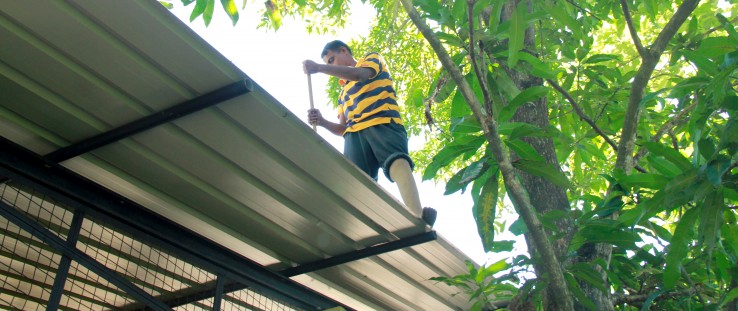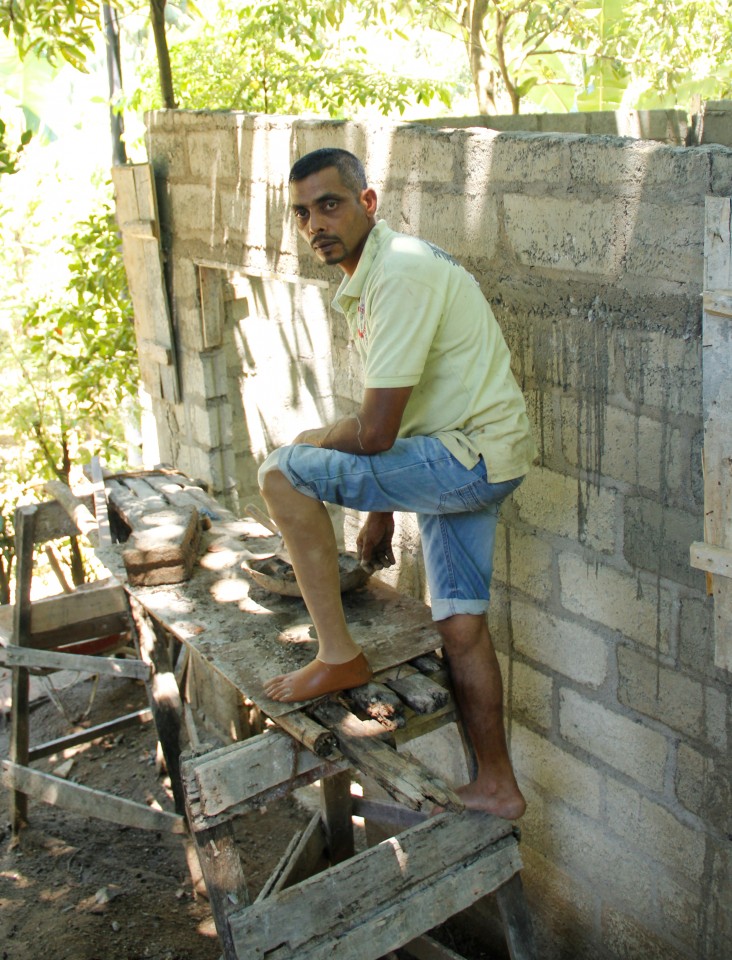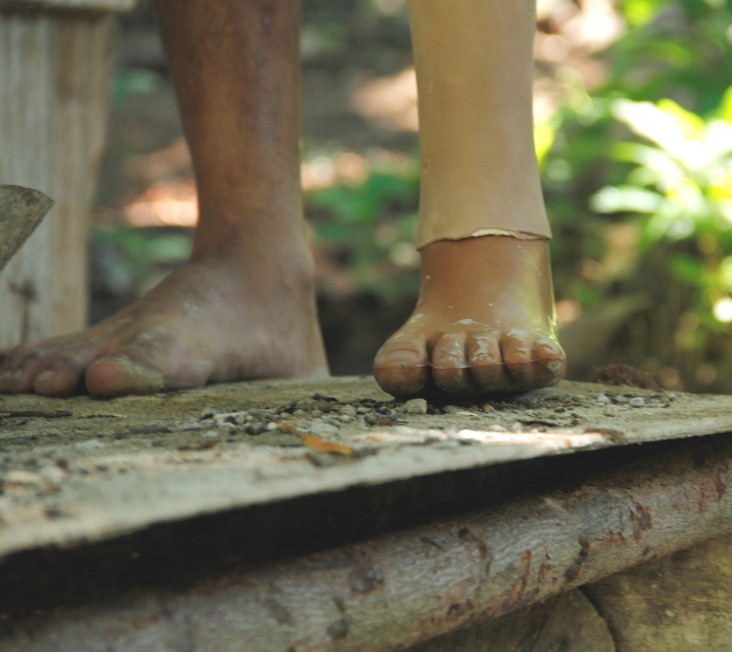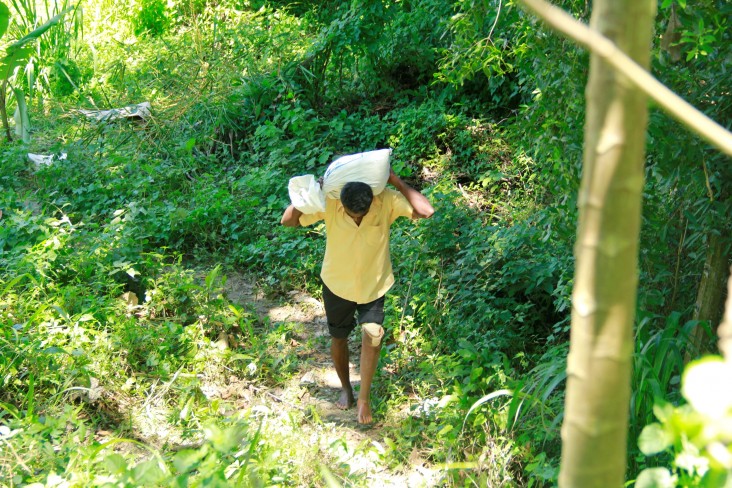 “I never imagined I could climb so high ever again,” said D.P. Jayaratne, who lost his leg to a landmine.
Center for Handicapped
“I never imagined I could climb so high ever again,” said D.P. Jayaratne, who lost his leg to a landmine.
Center for Handicapped
 “I never imagined I could climb so high ever again,” said D.P. Jayaratne, who lost his leg to a landmine.
Center for Handicapped
“I never imagined I could climb so high ever again,” said D.P. Jayaratne, who lost his leg to a landmine.
Center for Handicapped
Speeches Shim
Forty-five-year-old P.W.R. Palipana’s dreams crumbled before his eyes just like the bicycle he was riding when a lorry collided with him on his way home from work in the central hills of Sri Lanka.
A mason by profession and the sole breadwinner of a family of five, he agonized about his lost leg, livelihood and mobility. That was in 2007.
Ten years later his life is back on track, both professionally and personally, since he braved the steep climb to one of Sri Lanka’s tallest mountains without any assistance. “This shows that the artificial foot I am wearing is hard, durable and is able to cope with any distance and hard terrain. It is also far more flexible, lighter and comfortable than the pieces I used before,” says Palipana.
After the accident, a relative introduced him to the Center for Handicapped (CFH) in the central district of Kandy. Established in 1971 as a nonprofit, the center provides rehabilitation services for people with physical disabilities and amputees with support from national, international and non-governmental organizations and private sponsors.
There are approximately 160,000 amputees in Sri Lanka. Many are survivors of the 26-year conflict that ended in 2009; others lost limbs to traffic or work accidents, diseases or birth defects. Most of the amputees live and work in rural areas, where manual labor is the norm; hence, their prosthetics need regular replacement. The high cost of imported prosthetic components and raw material place high-quality limbs beyond the reach of many amputees and the existing prosthetic workshops cannot meet the country’s needs.
In 2010, as part of USAID’s three decades of support to people with disabilities in Sri Lanka, the Agency began looking for a solution to the critical shortage of prostheses. A feasibility study considered the country’s well-established rubber industry, and analyzed the use of advanced technology to produce and market a quality foot model in-country to replace imports.
USAID then worked with CFH and local and international experts to design and field test a foot model. Support also included expanding the Kandy facility, providing specialized equipment, conducting market research and devising strategies to sell the product to providers across the country. CFH also partnered with several public and private institutions as part of the project.
Climbing Mountains
Palipana could not afford the initial imported foot the center prescribed after screening and counseling sessions, so his sister bought it for him. “The first one broke in six months and I certainly had more pain on the upper leg and spine,” he reports.
So the old foot piece was replaced with a new USAID-supported foot piece, free of charge. He also received physiotherapy at the center’s residential facility on walking independently, balancing and climbing steps—and he received lessons that will allow him to make minor repairs to the prosthetic on his own.
Despite the steep climb in his daily commute, the artificial foot has stood the test of time.
“Thanks to a good grip, I am even able to climb scaffoldings carrying my tools and equipment. It is made of natural rubber and does not wear down as fast as the ones I wore before so I even walk without shoes,” explains Palipana. Most often, he forgets he is wearing an artificial foot.
During the last two years, the center has provided nearly 3,000 foot pieces to people like Palipana. These locally made, reasonably priced prosthetics are durable and sometimes around five times cheaper than the imported ones.
“This foot model is a clear winner that can reduce Sri Lanka’s dependence on costly imported prosthetics due to several reasons,” says USAID Mission Director for Sri Lanka and Maldives Andrew Sisson.
He says what goes into the product makes all the difference: careful attention to factors that affect durability such as local climatic conditions; locally produced raw material; customization and repair services; sizes ranging from 10 to 28; and short waiting times.
The center’s staff received extensive training, not only in manufacturing the foot pieces, but also in the related aspects such as storage of raw materials and finished products, quality control, pricing, marketing and sales. “These features place the CFH foot piece at a unique advantage over imported foot pieces,” concludes Sisson.
‘A Second Chance to Live’
For 47-year-old D.P. Jayaratne, who lost his limb to a landmine during the conflict in 1995, the outward appearance of a prosthetic matters just as much as comfort and durability.
“Two years ago, I was able to buy a foot that was very close to my skin color and had a natural shape and size. This helps me psychologically,” he says.
Since 1997, and up until two years ago, he has worn seven different artificial foot pieces. “This is the eighth and, thankfully, I have not had to even repair it yet. There is nothing I cannot do with the artificial foot as a daily laborer. It is reassuring that life can actually give one a second chance to live,” he said.
Research and development not only supported continuous improvements to CFH’s initial foot model, but also helped get the appropriate machinery and molds to strengthen productivity and quality, and to set up supplier chains.
The initiative has gone beyond its initial humanitarian objective to generate income and sustain the facility. Orders started in mid-2015 and the center reports that it has increased total income by more than 300 percent. CFH plows profits—earned from repairs or sales of its products to service providers—back to the development and expansion of the facility. The center, with the help of private sponsors and donations, also provides prosthetics free of charge to those who cannot otherwise afford them.
Some government institutions have expressed interest in the center’s work, opening up a promising new avenue of work and income.
“There is a large and sustained market for foot pieces in the country given the number of amputees and the lack of locally made prosthetics. The facility is capable of producing 6,000 artificial foot pieces a year. The center location also is an added advantage in that it lies at a road and rail hub facilitating an extensive sale and marketing network that would serve the whole country,” says CFH Chairman Shamil Peiris.
The chairman says there is no looking back for the center, which is now operating independently and without financial assistance from USAID. “Once we are well-established, the next step is to tap the overseas market. That is the future we see,” says Peiris.





Comment
Make a general inquiry or suggest an improvement.